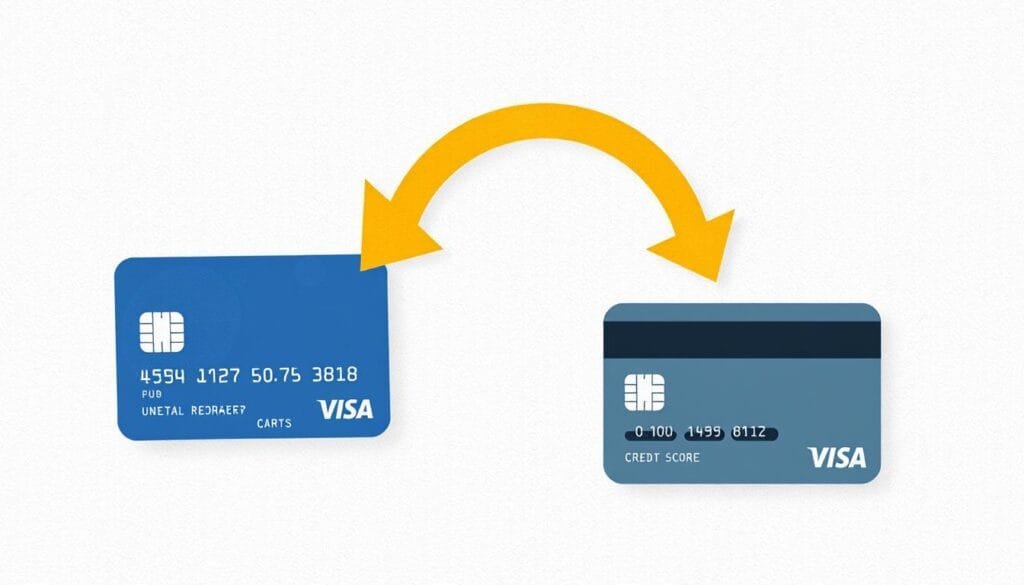Affiliate Disclosure: Travel with Plastic may earn a commission or referral bonus from some links on this site. These affiliate links help support our work and may influence the placement or promotion of certain products or services. However, our content is independently crafted to reflect honest opinions. Not all offers or products are included. There is no additional cost to users when they utilize our affiliate links.
Dreaming of premium travel cards but worried about your credit score? You’re not alone. With the right strategy, you can boost your score and increase approval chances.
Premium travel cards often require excellent credit scores, typically 750 or higher. Don’t let that discourage you. We’ll guide you through proven methods to improve your credit score.
Our tips will help you get closer to cards like the Platinum Card® from American Express or Chase Sapphire Reserve.
If you’re dreaming of unlocking a world of luxurious travel experiences, a premium travel card can be your ticket to adventure. However, before you start envisioning airport lounges and exclusive benefits, it’s crucial to think about your credit score. Understanding how to improve your credit score before applying for premium travel cards can significantly increase your chances of approval and secure you the most favorable terms. By focusing on essential strategies, including effective credit monitoring, you can elevate your financial standing and position yourself as a prime candidate for these elite cards. In this article, we’ll explore proven methods that will not only enhance your creditworthiness but also pave the way for unforgettable travel opportunities.
Credit repair takes time, but it’s achievable. Understanding what impacts your score is key. Taking strategic steps can significantly enhance your creditworthiness.
Let’s explore key takeaways to improve your credit score. These tips will set you on the path to those premium travel perks you’ve been eyeing.
Key Takeaways
- Aim for a credit score of 750 or higher for premium travel cards
- Focus on payment history, which accounts for 35% of your FICO score
- Keep credit utilization below 30% to maintain a healthy score
- Consider becoming an authorized user on a well-managed account
- Monitor your credit regularly and dispute any errors promptly
- Be strategic about timing your premium card application
Understanding Credit Score Requirements for Premium Travel Cards
Your FICO score is crucial for premium travel cards. These cards often have high credit standards. Let’s explore the credit score requirements and their importance.
FICO Score Ranges Explained
FICO scores range from 300 to 850. Here’s a quick breakdown:
- Exceptional: 800-850
- Very Good: 740-799
- Good: 670-739
- Fair: 580-669
- Poor: Below 579
Premium travel cards usually need scores in the “Good” to “Exceptional” range. Regular credit checks help track your progress towards these higher tiers.
Minimum Score Requirements for Top Travel Cards
A score of 700+ often qualifies you for many travel cards. The Chase Sapphire Preferred typically needs a minimum score of 670.
Premium cards may seek scores in the mid-700s or higher. Requirements vary between card issuers.
Why Premium Cards Have Higher Credit Standards
Premium cards offer valuable perks and high credit limits. Issuers use strict criteria to ensure cardholders manage these benefits responsibly.
Your credit score shows your financial habits. It helps card companies assess risk. A strong score boosts your chances for these coveted cards.
How to Improve Your Credit Score Before Applying for Premium Travel Cards
A high credit score is key for premium travel card approval. These cards usually require a score above 670. Let’s look at the FICO score ranges:
- 670 – 739: Good
- 740 – 799: Very Good
- 800 – 850: Exceptional
To boost your score, focus on key factors. Payment history is the most important, making up 35% of your FICO score. Set up auto-payments to avoid missing due dates.
Credit utilization is another crucial area, accounting for 30% of your score. Keep your card balances below 30% of your total credit limit. For better results, aim for 10% or less.
Take a well-rounded approach to credit improvement. Check your credit reports often and fix any errors. Maintain a mix of different credit accounts.
By following these tips, you’ll increase your chances of qualifying for premium travel cards.
Key Factors That Impact Your Credit Score Approval
Your credit score greatly affects your chances of getting premium travel cards. Let’s look at the main factors that can affect your application.
Income and Debt-to-Income Ratio
Your income is vital in the approval process. Lenders check your debt-to-income ratio to see if you can handle new credit. A lower ratio shows better financial health and boosts approval chances.
Current Credit Limits
Existing credit limits show your creditworthiness. Higher limits mean other lenders trust you with credit. This can help when applying for premium cards.
Payment History Impact
Your payment history is crucial for determining your creditworthiness. Paying bills on time can boost your credit score. A single late payment can drop your score by over 50 points.
Recent Credit Applications
Many credit inquiries in a short time can hurt your score. Space out your applications to improve your approval odds.
A low credit utilization ratio is key to a strong credit profile. Try to keep your ratio below 30% for better chances at premium travel cards.
People with top credit scores (800-850) have an average utilization ratio of just over 7%.
| Credit Score Range | Credit Category | Approval Likelihood for Premium Cards |
|---|---|---|
| 750+ | Excellent | High |
| 670-749 | Good | Moderate |
| 580-669 | Fair | Low |
| Below 580 | Poor | Very Low |
Focus on these key factors and keep a strong payment history. This will help you get approved for the premium travel card you want.
Reducing Your Credit Utilization Ratio
Your credit utilization ratio is vital for your credit score. It compares your credit card balances to your total available credit. This ratio can affect your chances of getting premium travel cards.
To find your credit utilization ratio, divide your total card balances by your credit limit. For instance, $6,000 in balances with a $12,000 limit equals a 50% ratio. Try to keep this ratio under 30% for a better credit score.
- Pay down existing balances through strategic debt repayment
- Request credit limit increases on current cards
- Keep old accounts open to maintain available credit
- Make small purchases on rarely used cards to prevent account closures
Your credit utilization ratio can make up 30% of your FICO score. Managing it well helps you qualify for top-tier travel cards. It’s a key step towards your travel rewards goals.
| Credit Score Range | Travel Card Approval Likelihood |
|---|---|
| 750-850 (Excellent) | High chance for premium cards |
| 700-749 (Good) | Likely for most travel cards |
| 650-699 (Fair) | Possible, with higher rates |
| 300-649 (Poor) | Unlikely, focus on credit-building |
Optimizing Your Payment History
Your payment history is crucial for your credit score. It makes up 35% of your FICO score. Let’s explore how to improve this vital component to boost your chances of getting premium travel cards.
Setting Up Automatic Payments
Automatic payments are a great way to maintain a positive payment history. This simple step reduces the risk of late or missed payments. It ensures your accounts are paid on time, every time.
Managing Payment Due Dates
Tracking multiple payment due dates can be tough. Try aligning your due dates to make them easier to manage. Many credit card issuers let you choose your preferred payment date.
Grouping your payments can simplify your financial planning. It also reduces the chances of forgetting a payment.
Dealing with Past Late Payments
Past late payments can hurt your score, but don’t worry. Their impact lessens over time. Focus on making consistent, on-time payments going forward.
This positive payment behavior will gradually improve your credit score. It will also help with credit repair efforts.
| Payment History Factor | Impact on Credit Score | Recovery Time |
|---|---|---|
| On-time Payments | Positive | Immediate |
| Late Payments (30+ days) | Negative | 12-18 months |
| Missed Payments | Severe Negative | 24-36 months |
A solid payment history is key to credit repair and better creditworthiness. These strategies will help you secure those coveted premium travel cards.
Managing Existing Credit Card Accounts
Smart credit card management can boost your credit score. This can increase your chances of getting premium travel cards. Let’s look at key ways to improve your credit profile.
Keeping Old Accounts Active
Older credit card accounts are crucial for a strong credit mix. They contribute to your credit history length, making up 15% of your score. Use these cards for small purchases to keep them active.
Requesting Credit Limit Increases
Higher credit limits can positively affect your credit utilization ratio. For example, $5,000 in balances across $50,000 in total credit limits equals 10% utilization. Increasing your total limit to $60,000 lowers this ratio to 8.33%.
| Scenario | Total Credit Limit | Balance | Utilization Ratio |
|---|---|---|---|
| Before Increase | $50,000 | $5,000 | 10% |
| After Increase | $60,000 | $5,000 | 8.33% |
Balance Transfer Strategies
Balance transfers can help repair credit. Moving high-interest balances to lower-rate cards helps pay off debt faster. This can improve your credit utilization.
Careful planning is needed to avoid new hard inquiries. These might temporarily lower your score.

Managing multiple cards responsibly can boost your credit score over time. Studies show scores can jump from 720 to over 800 in five years. This improvement can make you a strong candidate for premium travel cards.
Credit Monitoring and Score Tracking
Keeping tabs on your credit score is vital for snagging premium travel cards. It helps you track progress and find areas to improve. Many card issuers now offer free access to your credit score.
Experian, a major credit bureau, offers various monitoring services. Their free basic plan includes monthly FICO® Score updates. For $24.99 monthly, Experian’s Premium plan provides daily access to reports from all three bureaus.
Here’s a breakdown of credit score categories based on Experian estimates:
| Category | Score Range |
|---|---|
| Exceptional | 800-850 |
| Very Good | 740-799 |
| Good | 670-739 |
| Fair | 580-669 |
| Very Poor | 300-579 |
Most top travel rewards cards aim for folks with FICO scores of 670 and up. Regular monitoring helps you boost your score and qualify for these premium cards.
Building a Diverse Credit Mix
A well-rounded credit mix boosts your FICO score. Different credit accounts increase your creditworthiness. This improves your chances of getting premium travel cards.
Types of Credit Accounts
Credit accounts fall into two main categories:
- Revolving credit: Credit cards and lines of credit
- Installment credit: Mortgages, auto loans, and student loans
A mix of both types shows responsible credit management. Aim for at least five credit accounts. This helps avoid a “thin” credit file.

Impact of Credit Variety on Score
Your credit mix makes up 10% of your FICO score. This factor can affect premium travel card applications. An ideal mix includes revolving and installment accounts.
Building a diverse credit mix takes time. Focus on positive payment history and low credit use. This approach improves your overall credit profile.
Maintaining good credit habits increases your chances of getting premium travel cards. Remember, responsible credit management is key to success.
Timing Your Premium Card Application
Timing is key when applying for premium travel cards. Your credit score affects approval chances. Let’s explore how to boost your score and time your application well.
Best Time to Apply
Premium travel cards typically require a credit score of 720 or above. Boost your score before applying. Pay down balances and make timely payments.
Application Spacing Strategy
Space out your credit card applications to protect your credit score. Wait at least 90 days between applications. This approach reduces multiple hard inquiries, which can lower your score.
Pre-qualification Benefits
Use pre-qualification tools offered by card issuers. These soft inquiries don’t affect your credit score. They give you an idea of your approval odds.
Pre-qualification helps avoid unnecessary hard inquiries if approval chances are low. It’s a smart way to protect your credit score.
Some issuers have specific application rules. American Express limits individuals to five personal credit cards. They also restrict welcome offers to once per lifetime for each card.
Bank of America follows a 2/3/4 rule for new card approvals. This limits the number of cards you can get within certain time frames.
Understanding these factors helps you time your application wisely. You’ll be better positioned to secure that premium travel card. Enjoy its luxurious benefits!
Dealing with Application Rejection
Rejection for premium travel cards can be tough, but it’s not the end. Even high credit scores don’t guarantee approval. Banks have stricter criteria now, making these cards harder to get.
Don’t give up. There are ways to boost your chances and fix your credit.
If denied, ask why within 60 days. Credit card companies must tell you under the Equal Credit Opportunity Act. This info is key for your credit repair plan.
It can guide you on improving your credit score before trying again.
Try calling the issuer’s reconsideration line. Explain why you want the card and how you’ll use it wisely. Be aware of rules like Chase’s 5/24 policy.
While improving your score, look into secured or student cards. These can build credit history with less strict requirements. Remember, each application causes a hard inquiry.
This can lower your score by up to 5 points. Keep an eye on your credit report. Focus on paying bills on time.
With patience and smart credit habits, you’ll have a better shot next time.
Conclusion
Boosting your credit score is key to unlocking amazing travel experiences. Credit scores range from 300 to 850. Aim for “good” (700-749) or “excellent” (750-850) to increase approval chances for top cards.
Improving your credit takes time and dedication. Focus on lowering credit utilization and paying bills on time. Manage existing accounts wisely. These steps can lead to big improvements in your score.
Many premium cards offer great rewards for your efforts. Some give 4x points on dining and travel purchases. Others provide sign-up bonuses of 60,000 to 80,000 points.
Follow the tips in this guide to boost your credit score. Maintain good credit habits to enjoy these benefits. Soon, you’ll be ready for your next adventure with confidence.

